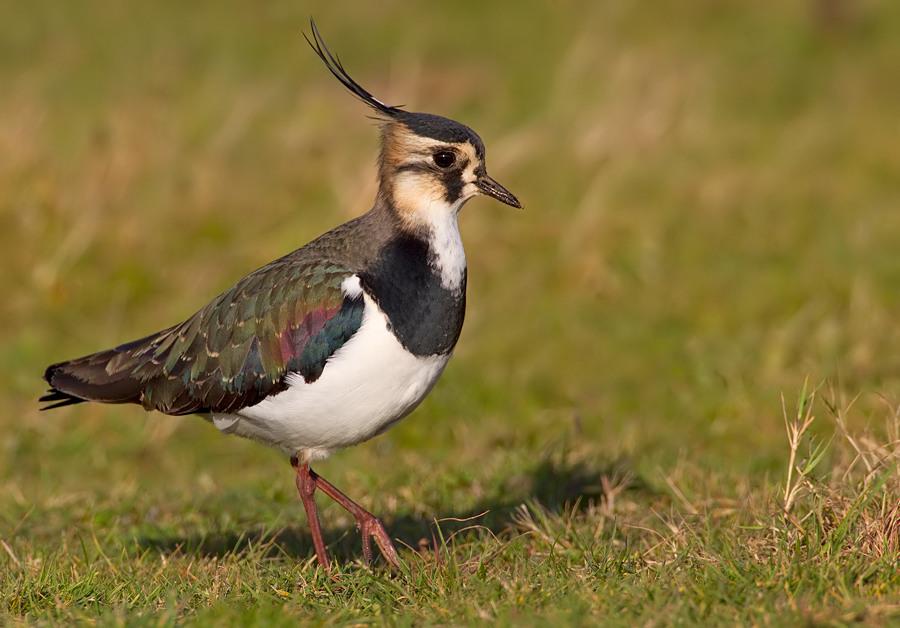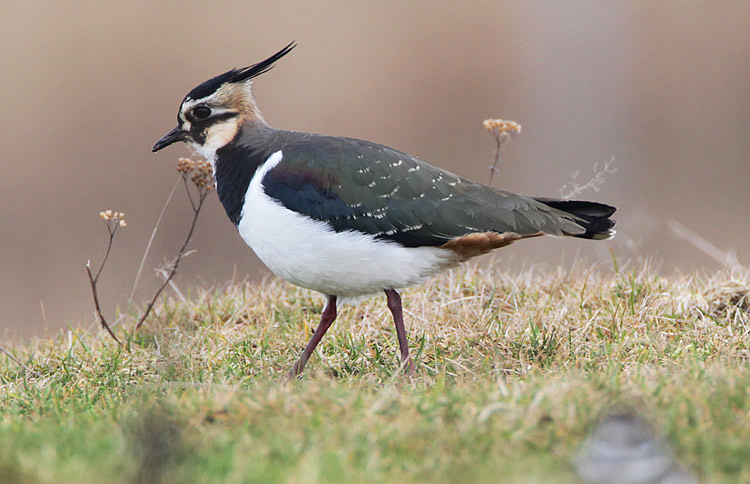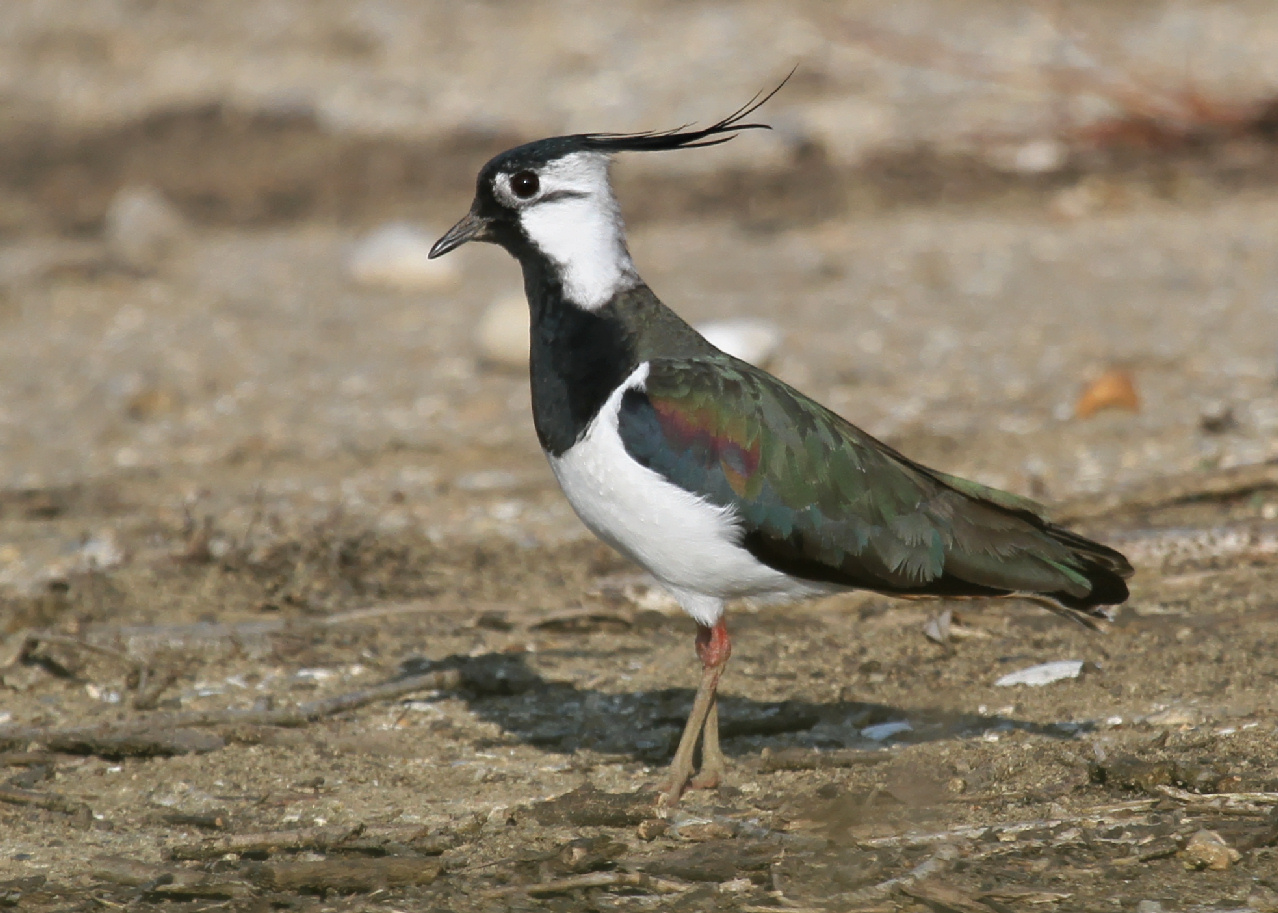
Vanellus vanellus
SUBFAMILY
Vanellinae
TAXONOMY
Vanellus vanellus Linnaeus, 1758, Sweden. Monotypic.
OTHER COMMON NAMES
English: Eurasian plover, green plover, pewit; French: Vanneau
huppй; German: Kiebitz; Spanish: Avefrнa Europea.
PHYSICAL CHARACTERISTICS
11.5–13 in (29–33 cm). Spring weights: males 6–9 oz (170–255
g), females 7.7–9.9 oz (218–280 g). Adult summer and fall
weights average 8.2 oz (232 g). Elongated black crest, thick
blackish neck band, and glossy green back are diagnostic. Face
is black with a dark line extending under the eye. Tail is white
and has a broad sub-terminal black band. Tail coverts are cinnamon
rufous. Underparts are white, grading to a light cinnamon
on the undertail coverts.
DISTRIBUTION
Breeds in Europe and Asia from the British Isles (occasionally
to Iceland) to south Ussuriland and south to northwest Morocco,
eastward to north Greece, Iran, and Mongolia. Winter
range extends southward to the Mediterranean Basin, northwestern
India, and eastern China. Breeding has also been reported
from Japan.
HABITAT
HABITAT
requirements are broad, and the species can be found
nesting from boreal to steppe and even desert habitats. Like
other charadriids prefers broad open areas, including grasslands,
fields, moors, bogs, and heathlands.
BEHAVIOR
Migrating flocks are usually small, but huge flocks are also
recorded. Winter flocks often contain 100 or more birds, and
flocks of over 5,000 have been reported. During winter some
individuals feeding in flocks vigorously defend small feeding
territories. They also spend time on communal areas where
bathing, resting, and preening occur.
FEEDING ECOLOGY AND DIET
Foraging
BEHAVIOR
is typical charadriid
BEHAVIOR
of running,
stopping, and pecking. They feed extensively on earthworms,
but diet also includes a variety of invertebrates. Reliance on
earthworms decreases during unusually dry weather. During
unusually cold weather they may eat cattle dung. They are often
the victims of kleptoparasitism by gulls—especially blackheaded
gulls (Larus ridibundus).
REPRODUCTIVE BIOLOGY
Mature in the first year, lapwings often do not nest until their
second or even third year. Solitary nesting is common, but
breeding densities are sometimes high (nine pairs in less than a
hectare). Fidelity to territory is high, with 70% of lapwings returning
to birthplaces in the spring. Male performs elaborate
territorial and courtship displays over breeding territory.
Flights include a non-vocal humming sound and a three-motif
song. At times, the primaries emit loud buzzing noises. Seasonal
monogamy is the rule but a weak pair bond and weak
territories increase the probability of polygynous mating. Male
may fly directly onto the female’s back for copulation. A single
brood is produced. Four is usual clutch size, occasionally three.
Incubation requires about 24–34 days. Parental duties are
shared, but one parent—usually the female—deserts before the
brood fledges. Fledging occurs in 30–42 days. There are reports
of males with two to three females, and simultaneous
bigamous matings by males seem to occur often.
CONSERVATION STATUS
Not threatened. European breeding area has expanded especially
northward.
SIGNIFICANCE TO HUMANS
Eggs were commonly collected for food. There are reports
from Holland of a single collector taking over 2,000 eggs in a
single season. It remained legal to collect the eggs in Britain
until at least the 1970s.
Other popular Animals
Photo Gallery of - Northern lapwing




 Animalia Life
Animalia Life